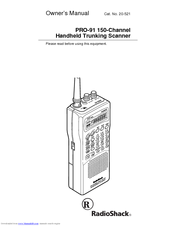Radio Shack Pro 62 Owners Manual

Digital Trunking Handheld Radio Scanner Thank you for purchasing your Digital Trunking Handheld Radio Scanner from RadioShack. 20-106 PRO-106 Please read this user.
I've recently got a hold of my dad's old radio scanner. It's a Radio Shack Pro-62, and appears to be in complete working condition. I've been blaming the fact that I haven't been getting any reception on it to me being very new at this, and probably just inputting bad frequencies for our area. I was hoping for some tips on how to get some results.
I know the police change the frequencies often, but if I leave the scanner scrolling through a few frequencies, I'm bound to hit something, right? And what do you guys usually listen to? Just curious =) Also, my dad heard from his friend (Steve Todd) that he modified his to pick up the 'locked out' frequencies. Such as the 87.8-108MHz AM/FM frequencies used by radio broadcasters.
Or the 26-27MHz used by CB. Have you heard anything about this?
Thanks for reading, please help, -Mike JSnoik, 0:01 น.  Hi Mike, I don't know if you have the manual for it.
Hi Mike, I don't know if you have the manual for it.
If not check out: That is an shortened version on Radio Shack's site. Next I would recommend checking out Radio Reference for information on frequencies in your area: If you happen to be in Atlantic Canada, check out: for frequencies and for a message board with up to date information. I don't know if you are familiar with Trunk Tracking. A lot of the services have changed to this and from what I see the scanner you have does not Trunk Track.
In case you are not familiar, a really basic description: In the old system, each service would have a fixed frequency - for instance Marine Channel 12 is 156.600. If you tune into that frequency, it will always be Marine related. Sometimes Police and Fire Departments had a number of frequencies. Police here had Dispatch, CPIC (Canadian Police Information Centre), Car to Car, etc. In a Trunk System, the system has a number of frequencies. Our local one has 16 frequencies.
One of those is a data channel, which sounds like sound blurbs. BUT the number of services and channels in use is well over a hundred. Each channel used by a service is assigned a Talk Group. So when someone from a Talk Group goes to talk on a Trunk System, the system computer looks for a free frequency among the 15 other frequencies.

It sends out a data blurb to all the radios within the Talk Group to change to that frequency for reception. When he stops talking the frequency is freed up and the radios reset. The next time he talks, or someone answers, it may be on another frequency from the system.
Business knowledge for it in investment banking pdf free download. This should make useful for those who wish to learn investment techniques for practical use and those wishing to progress further into the theory of finance. This book presents the essential elements of investment analysis as a practical tool with a firm theoretical foundation. Author(s): Guru Jambheshwar University of Science and Technology.
Especially, if someone else, from another Talk Group starts speaking in the meanwhile. Even for a basic description, it can get a little long to explain. Also, one thing that has cropped up in recent years, is that some of the Trunking communications has gone digital. Like cell phones.
They would require a scanner that is able to receive digital. Your scanner can receive the 800 band of frequencies. So, if your area has gone to Trunking, you may still be able to hear them. But as the section on Trunking explains, the same frequency may have a variety of conversations going.